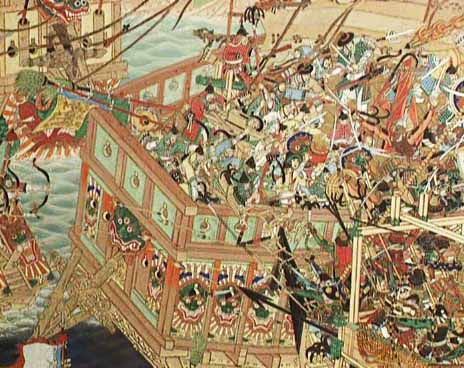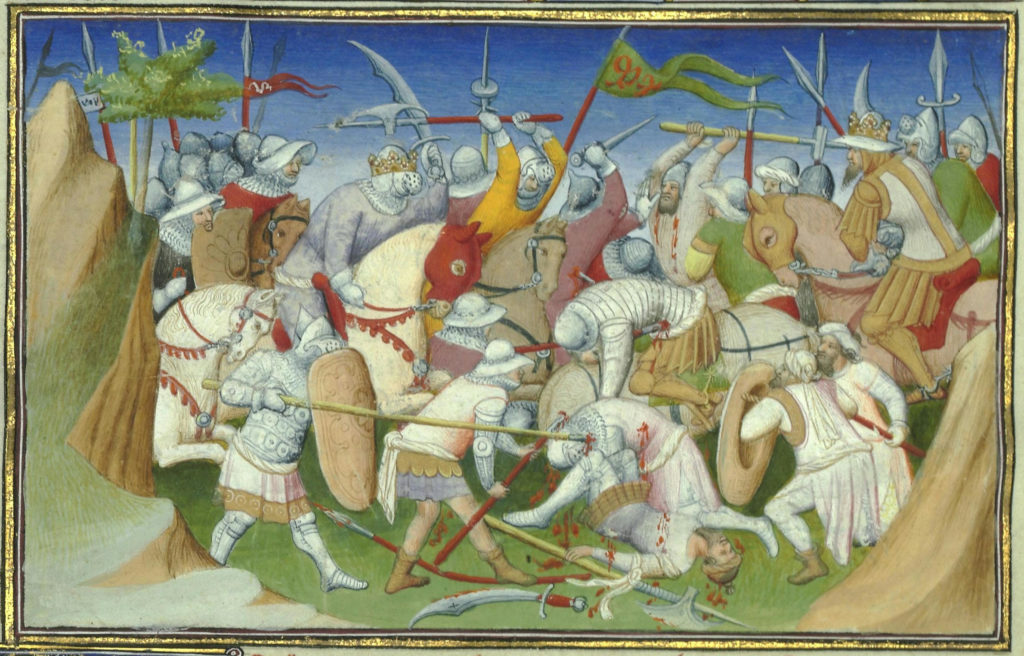This Week in History recalls memorable and decisive events and personalities of the past.
26th October 1597 – Imjin War: Korean Admiral Yi Sun-sin routs the Japanese Navy of 300 ships with only 13 ships at the Battle of Myeongnyang

During the 16th century, Japan experienced a period of internal strife and civil war as the Samurai, a class of feudal warlords, battled to become the Shogun, the military dictator of Japan and the controller of the divine Emperor.
During the 1560s, a warlord from the Oda clan called Oda Nobunaga began a series of campaigns to crush the various factions of Japan’s civil conflicts and reunify the country under his rule.

Nobunaga was extremely successful and soon became Japan’s most powerful warlord. However, in 1582, one of his followers turned on him, killing him in an ambush, and sending Japan back into civil war.
One of Nobunaga’s chief lieutenants was a peasant called Toyotomi Hideyoshi, who had risen through the ranks of Nobunaga’s service despite his fairly humble background. In the chaos that followed Nobunaga’s death, Hideyoshi managed to emerge as the most powerful warlord in Japan and set himself up as the ‘Chancellor of the Realm’, as, not being a Samurai, he could not claim to be Shogun.

After unifying the realm under him and seeking to continue the dream of his master, Nobunaga, to conquer China, Hideyoshi began making preparations for an invasion of China’s ally, Korea, in 1591.
In 1592 the Japanese landed in Korea and began what was called the Imjin War. At first, the Japanese armies were very successful and Hideyoshi’s huge army of 158 000 troops smashed the Korean army and forced the Koreans to beg for aid from their ally, China. Japan quickly occupied much of Korea up to the city of Pyongyang.
The Ming Dynasty in China soon sent a large relief force and this army managed to push the Japanese back from the city of Pyongyang, and into southern Korea. The Japanese halted the advance of the Chinese-Korean army at the Battle of Byeokjegwanin in 1593 and a stalemate of sorts set in.
At the same time, a battle was raging for control of the sea lanes between the Korean navy and the Japanese navy. The Japanese needed constant reinforcements and supplies from Japan to sustain their campaign, as southern Korea was filled with resistance to their rule and had been devastated by their invasion. The Korean navy constantly tried to disrupt these sea lanes.
In August of 1597, almost the entire Korean navy was destroyed by the Japanese at the Battle of Chilcheollyang, in which the Koreans lost 188 of their 200 warships. This was partly as a result of Japanese spies managing to have the experienced Korean admiral, Yi Sun-sin, removed from control of the Korean navy.

After the devastating defeat, the Koreans reappointed Admiral Yi Sun-sin, who, with his 13 remaining ships, set himself up for a final last stand at the Myeongnyang Strait in south-western Korea. Facing him was a force of 130 Japanese warships. When, prior to this battle, the Korean king ordered the navy to disband, thinking it was now too weak to do anything and should join the land armies, admiral Yi Sun-sin responded: ‘Even though our navy is small, as long as I live the enemy cannot despise us.’
Yi Sun-sin, utilising his knowledge of the sea currents in the area and luring the Japanese into a narrow channel, set a trap for them with his tiny force of ships. The trap was sprung on 26 October 1597. In the ensuing battle, the Japanese navy was decisively defeated and forced to flee, with the loss of 30 ships. The Korean fleet survived with the loss of only 10 men.
In an act of revenge against the Korean admiral, the Japanese attacked his home village of Asan and killed his youngest son. Following the defeat, the naval war shifted against the Japanese and the Chinese fleet soon arrived to help Korea take control of the sea lanes. The Japanese army was soon strangled of supplies and forced to retreat from the field, abandoning their invasion of Korea in 1598.
27th October 1922 – A referendum in Rhodesia rejects the country’s annexation to the South African Union

Rhodesia was established in 1890 when Cecil John Rhodes, at the head of his British South Africa Company, led a group of British settlers and soldiers into north-eastern Mashonaland, conquering the territory with minimal resistance from the local Shona, who were divided and weak. The new territory then fought the local regional power, the Ndebele, in two wars in 1893 and 1896, defeating them and establishing the company’s control over a large region between the Limpopo and Zambezi rivers.
In 1895, this territory was officially named Rhodesia after its founder and developed into what was effectively a British colony, building towns and settling European colonists in the area.
Over the next few years, the region’s settler-elected legislative body came to acquire increasing power and, by 1922, the British government decided that the time was right to transform Rhodesia from a company territory into a self-governing colony of the crown.
There were two proposals on how to achieve this; delegating responsible government functions to Rhodesia’s mostly white voting population, or integrating the territory into the Union of South Africa. It was decided to leave this choice up to the settler population in a referendum.
The referendum was held on 27 October 1922, with the British preferring union with South Africa but largely staying out of the process. In the final tally, Rhodesian self-governance received 59% of the vote and union with South Africa received 40%.
After this, Rhodesia became a fully-fledged self-governing colony of the British Empire until the declaration of independence by the Rhodesian government in 1965.
28th October 1531 – Abyssinian–Adal war: The Adal Sultanate seizes southern Ethiopia

There has been an Ethiopian state since the time of the Roman Empire, perhaps even before. Ethiopia is indeed one of Africa’s oldest nations and a true home-grown multi-ethnic empire. Unfortunately, the lack of written sources and the difficulty of doing archaeology in Ethiopia have left its fascinating history rather under-explored.
The Ethiopian Empire, which officially came to an end in 1974 after a military coup by pro-communist forces in the Ethiopian army, began somewhere around the year 1290 when a local prince established the Solomonic Dynasty, claiming decent from King Solomon of the Bible. That dynasty would rule Ethiopia until 1974 when Emperor Haile Selassie was deposed. Ethiopia is also unique for being one of the first states in the world to adopt Christianity as its official religion, shortly after Armenia and the Roman Empire.

Over the centuries, Ethiopia has been plagued by two main enemies; Islamic rulers in Egypt to the north and, most importantly, Muslim Somalis who live to the east and south of Ethiopia’s core territory. In the 16th century, the Somalis of the east were mostly governed by a powerful sultanate called the Sultanate of Adal, which had struggled for control over the Ethiopian highlands for decades, and would almost end the Solomonic Dynasty.
In 1529, the warriors of Adal had brought a fearsome new weapon to the battlefields of Africa: the matchlock musket. In March of 1529 the forces of Adal defeated an Ethiopian army of 15 000 ‘knights’ using their new firearms and so shifted the balance of forces in the region away from Ethiopia.
In 1531, the Somalis attacked again and this time they not only had firearms but cannons provided to them by the Ottoman Empire. Unused to facing firearms, the Ethiopian troops panicked and fled the field of battle, opening the way to a Somali invasion of the Ethiopian highlands.
For the next nine years, Adal would occupy southern Ethiopia, fighting to pacify the local population and looting and burning churches and towns across the region. In 1540 the Somalis captured the Ethiopian emperor himself, and all seemed lost.
Resistance continued, however, and the Ethiopians soon received a new ally. The Portuguese Empire had lately made an appearance in the Indian Ocean world and sought to do battle with its enemy, the Ottoman Empire, as a crusade against Muslims and a means to secure trade with India. The Portuguese allied themselves with the Christian Ethiopians and began assisting them in fighting Adal and its Ottoman supporters.
In 1543, a combined Portuguese and Ethiopian army defeated a Somali/ Ottoman force much larger in size at the Battle of Wayna Daga. In this battle, the leader of the Somali Adal forces, Imam Ahmad, was beheaded by an Ethiopian warrior. The Somali army collapsed and would retreat from Ethiopia later that year.
Decades of on-and-off war would follow, with both sides managing to burn the other’s capital city. In 1577 the Ethiopians again defeated Adal and both sides established a more lasting peace. The Ethiopians then turned to face a new threat, the Oromo, a new nomadic people from further south in Africa who began migrating into Ethiopian territory as a result of the lapse of control by Ethiopia due to its war with Adal.
If you like what you have just read, support the Daily Friend

